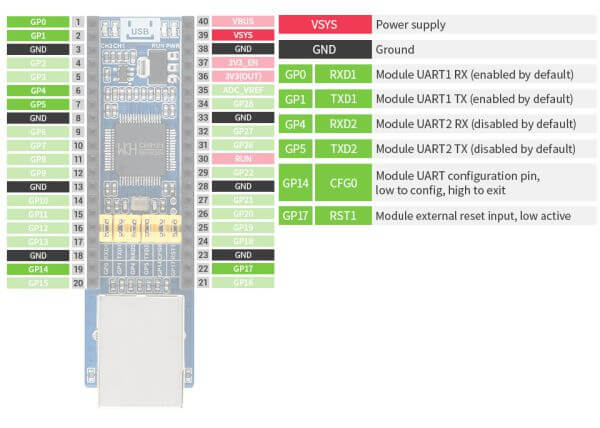- sales/support
Google Chat: zj734465502@gmail.com
- sales
+86-0755-88291180
- sales01
sales@spotpear.com
- sales02
dragon_manager@163.com
- support
tech-support@spotpear.com
- CEO-Complaints
zhoujie@spotpear.com
- sales/support
WhatsApp:13246739196
Raspberry Pi Pico-ETH-CH9121 User Guide
Overview
Ethernet To UART Converter For Raspberry Pi Pico, 10/100M Ethernet, Enabling Network Communication Through UART.
Features
- Standard Raspberry Pi Pico header, supports Raspberry Pi Pico series.
- Onboard Ethernet to UART transparent transceiver, 2-CH UART, standalone transparent transmission for each channel.
- Onboard jumpers for pin configurations.
- Embedded Ethernet MAC and PHY layers.
- Bi-direction transparent data transmission between UART and Ethernet.
- 10/100M, full-duplex/half-duplex auto-negotiation Ethernet interface, 802.3-compliant.
- Auto-MDI/MDIX, detect and switch cable type automatically.
- Supports DHCP auto-obtained IP and DNS domain access.
- Network parameter configuration like chip operating mode, port, IP, via host computer software or UART command
- Four operating modes: TCP CLIENT, TCP SERVER, UDP CLIENT, UDP SERVER.
- Full-duplex or half-duplex UART communication supports RS485 RX/TX auto switch (external RS485 controller required).
- Supports virtual serial port software (provided).
- KEEPALIVE mechanism support.
Specifications
- Operating votlage:3.3V/5V
- Operating mode: TCP/UDP
- UART TTL: 3.3V / 5V compatible
- Operating temperature: ~40°C ~ 85°C
- Operating current: 140mA
- Baudrate: 300bps ~921.6Kbps
- Dimensions: 74.54 x 21.00 (mm)
- Storage Condition: -55°C ~ 125°C
Pinouts
About the CH9121
The CH9121 is a transparent network serial port chip that supports bidirectional and transparent transmission of serial port data and network data. It supports four working modes: TCP CLIENT/SERVER and UDP CLIENT/SERVER. The serial port baud rate ranges from 300bps to 921600bps. Before using, you should set network and serial port parameters for the chip by the NetModuleConfig.exe software or serial commands. After the configuration is complete, the CH9121 saves the configuration parameters to the internal storage space. After the chip is reset, the CH9121 could work based on the saved configuration values.
Default Parameters
The UART 2 is disabled and the UART 1 works in TCP CLIENT mode by default.
- The network parameters of UART1 (port 1)
- Device IP: 192.168.1.200
- Subnet mask: 255.255.255.0
- Device port: 2000
- Target IP: 192.168.1.100
- Target port: 1000
- The Serial parameters of port
- Baud rate: 9600
- Timeout: 0
- Data bit: 8
- Stop bit: 1
- Parity bit: None
- Clear buffer: Never
Configuration
TCP Client
- Connect the Pico-ETH-CH9121 (ETH module hereafter) to the router, and use the host PC as a TCP server. The PC should be connected to the same LAN as the ETH module
- Use the SSCOM software, set the port to TCP server and you can check the local IP (the Target IP) and the port (Target port)
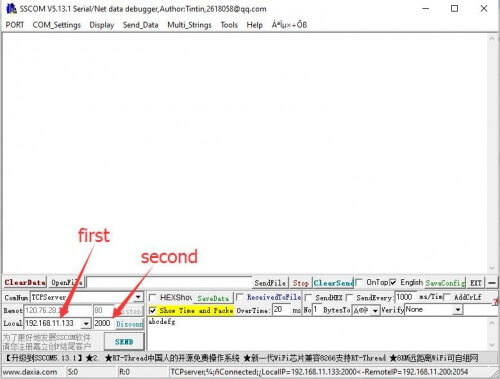
- Run the NetModuleConfig.exe software on your PC
- Click the Search button to detect device
- Double-Click the device detected, then you can modify the network parameters in the left area
- After configuration, the ETH module will auto-restart, wait for a moment, search the device again and check the setting.
- Note that you need to modify the parameters according to the actual situation. The Mode should be TCP CLIENT, target IP and port is same as the TCP server.
- After setting, you can listen to the data by the SSCOM software
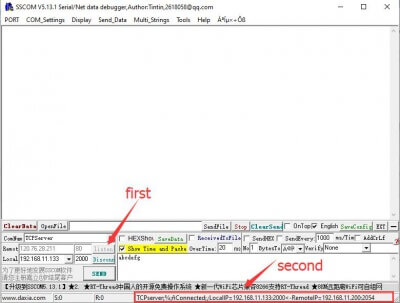
TCP SERVER
- Connect the Pico-ETH-CH9121 (ETH module hereafter) to the router, and use the host PC as a TCP CLIENT.
- Run the NetModuleConfig.exe software on your PC
- Click the Search button to detect the ETH module
- Double-click the device detected
- Set the mode to TCP SERVER and modify other parameters according to the actual situation.
- Click the Set ALL button to save the setting
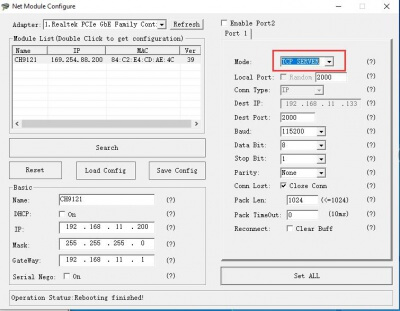
- User the SSCOM software, configure as TCP CLIENT, and connect to the SERVER(The ETH module)
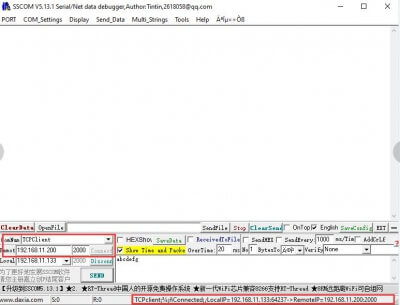
UDP CLIENT/SERVER
The UDP modes are the same as the TCP, the only difference is the mode is UDP CLIENT/SERVER but not the TCP CLIENT/SERVER.
Pico Quick Start
Download Firmware
- MicroPython Firmware Download
- C_Blink Firmware Download
Hardware connection
| ETH | Pico | Description |
|---|---|---|
| 5V | VSYS | Power input |
| GND | GND | Ground |
| RXD1 | GP0 | UART 1 data input |
| TXD1 | GP1 | UART 1 data output |
| RXD2 | GP4 | UART 2 data input |
| TXD2 | GP5 | UART 2 data output |
| CFG0 | GP14 | Network configrate enable pin |
| RST1 | GP17 | Reset pin |

- If you want to use the screen, please unplug the CFG0 mini jumper cap on the Pico-ETH-CH9121.
- Remove the jumper cap on the RST1 pin, and after powering on the pico, the Pico-ETH-CH9121 will start directly, don't need to download the program.
Configurate Environment
To use the Pico, you need to configure your PC or the Raspberry Pi first.
Please refer to the official guide about the setting Pico Manual
Examples
We use Raspberry Pi board as examples
Download examples
Open the terminal and run the following commands:
sudo apt-get install p7zip-full cd ~ sudo wget https://www.waveshare.com/w/upload/a/a4/Pico_ETH_CH9121_CODE.7z 7z x Pico_ETH_CH9121_CODE.7z -o./Pico_ETH_CH9121_CODE cd ~/Pico_ETH_CH9121_CODE cd Pico/c/build/
C examples
- Go intot the c directory.
cd ~/Pico_ETH_CH9121_CODE/Pico/C/
- You can use the Pico_ETH_CH9121_CODE/Pico/C/Serial Port Parameter Configuration: configure module.
- Pico_ETH_CH9121_CODE/Pico/C/RX_TX: Echo examples, receive data and echo
- Go into examples directory and export sdk
cd build export PICO_SDK_PATH=../../pico-sdk
- You need to modify the path to the actual one if you use direct path.
- Generate the Makefile file
cmake ..
- Build the examples.
make -j9
- After building, copy the .uf2 file to the Pico.
- Press the BOOTSEL button of Pico and hold it, connect the pico to your Pi by micro USB cable and then release the button. The portable disk RPI-RP2 is recognized, you need to copy the uf2 file to the portable disk.
cp main.uf2 /media/pi/RPI-RP2/
Python examples
Windows
1. Press and hold the BOOTSET button on the Pico board, connect the pico to the USB port of the computer through the Micro USB cable, and release the button after the computer recognizes a removable hard disk (RPI-RP2).
2. Copy the rp2-pico-20210418-v1.15.uf2 file in the python directory to the recognized removable disk (RPI-RP2).
3. Open Thonny IDE (note: use the latest version of Thonny, otherwise there is no Pico support package, the latest version under Windows is v3.3.3).
4. Click Tools->Settings->Interpreter, select Pico, and the corresponding port as shown in the figure.
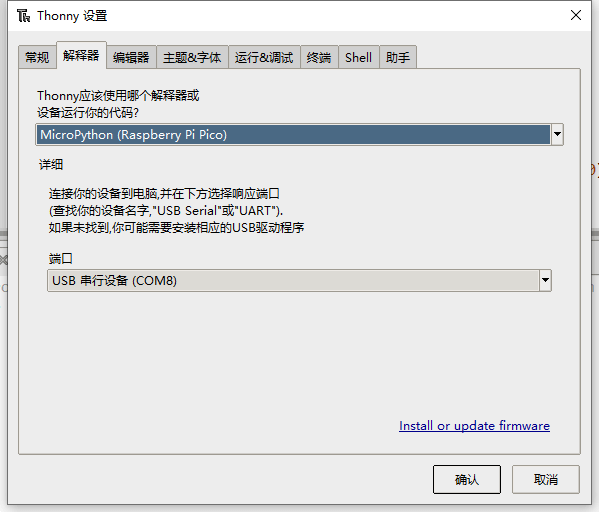
This demo provides two programs:
Serial Port Parameter Configuration.py: This program is used to configure the mode through the serial port.
RX_TX.py: This is used to send and receive information and return what is received.
5. File->Open->RX_TX.py, click to run, as shown below:
Note: If you want to start automatically, please rename RX_TX.py to main.py and save it to Pico.
Raspberry Pi
- Press and hold the BOOTSEL button of pico, connect it to Raspberry Pi or PC by micro USB cable, and then release the button
- The Pico is recognized as portable disk RPI-RP2, copy the rp2-pico-20210418-v1.15.uf2 file to the portable disk
- Open the Thonny IDE
- Choose Tools -> Options .. -> Interpreter
- Choose MicroPython(Raspberry Pi Pico) and the related port.

- If your Thonny IDE doesn't support Pico, you need to update it to the newest version
sudo apt upgrade thonny
- Click File -> Open... -> python/RX_TX.py to run the codes.
Codes Description
C codes
- Data types:
#define UCHAR unsigned char #define UBYTE uint8_t #define UWORD uint16_t #define UDOUBLE uint32_t
- Initailize module:
void CH9121_init(void);
- Parameters for configuring modules
UCHAR CH9121_Mode //Mode UCHAR CH9121_LOCAL_IP[4] //Device IP UCHAR CH9121_GATEWAY[4] //Gateway UCHAR CH9121_SUBNET_MASK[4] //Subnet mask UCHAR CH9121_TARGET_IP[4] //Target IP UWORD CH9121_PORT1 //Device port UWORD CH9121_TARGET_PORT //Target port UDOUBLE CH9121_BAUD_RATE //baud rate of serial
- You can configure the module by the following functions with serial commands
void CH9121_TX_4_bytes(UCHAR data, int command); //Can be used to configure the mode, random port, disconnect network, clear buffer, DHCP, UART2 void CH9121_TX_5_bytes(UWORD data, int command);//Can be used to set the port of Serial void CH9121_TX_7_bytes(UCHAR data[], int command);//Can be used to set IP, subnet mask, gateway. void CH9121_TX_BAUD(UDOUBLE data, int command);//Can be used to set the baud rate of Serial. void CH9121_Eed(); // Can be used to save settings to EEPROM, enable the setting, reset module, exit from setting mode
Python
You just need to modify the Serial Port Parameter Configuration.py for setting the module.
ODE = 1 #0:TCP Server 1:TCP Client 2:UDP Server 3:UDP Client GATEWAY = (169, 254, 88, 1) # GATEWAY TARGET_IP = (169, 254, 88, 17)# TARGET_IP LOCAL_IP = (169,254,88,70) # LOCAL_IP SUBNET_MASK = (255,255,255,0) # SUBNET_MASK LOCAL_PORT1 = 5000 # LOCAL_PORT1 LOCAL_PORT2 = 4000 # LOCAL_PORT2 TARGET_PORT = 3000 # TARGET_PORT BAUD_RATE = 115200 # BAUD_RATE




